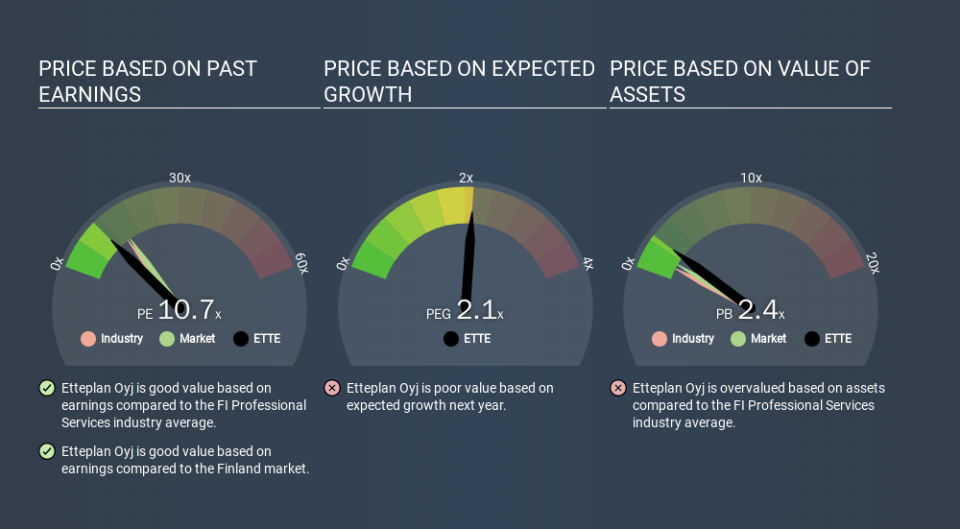What Is Etteplan Oyj's (HEL:ETTE) P/E Ratio After Its Share Price Tanked?

Unfortunately for some shareholders, the Etteplan Oyj (HEL:ETTE) share price has dived 30% in the last thirty days. The recent drop has obliterated the annual return, with the share price now down 7.0% over that longer period.
All else being equal, a share price drop should make a stock more attractive to potential investors. In the long term, share prices tend to follow earnings per share, but in the short term prices bounce around in response to short term factors (which are not always obvious). The implication here is that long term investors have an opportunity when expectations of a company are too low. One way to gauge market expectations of a stock is to look at its Price to Earnings Ratio (PE Ratio). A high P/E implies that investors have high expectations of what a company can achieve compared to a company with a low P/E ratio.
Check out our latest analysis for Etteplan Oyj
Does Etteplan Oyj Have A Relatively High Or Low P/E For Its Industry?
We can tell from its P/E ratio of 10.68 that sentiment around Etteplan Oyj isn't particularly high. We can see in the image below that the average P/E (13.5) for companies in the professional services industry is higher than Etteplan Oyj's P/E.
Etteplan Oyj's P/E tells us that market participants think it will not fare as well as its peers in the same industry. Since the market seems unimpressed with Etteplan Oyj, it's quite possible it could surprise on the upside. You should delve deeper. I like to check if company insiders have been buying or selling.
How Growth Rates Impact P/E Ratios
P/E ratios primarily reflect market expectations around earnings growth rates. Earnings growth means that in the future the 'E' will be higher. Therefore, even if you pay a high multiple of earnings now, that multiple will become lower in the future. And as that P/E ratio drops, the company will look cheap, unless its share price increases.
Etteplan Oyj increased earnings per share by an impressive 14% over the last twelve months. And earnings per share have improved by 18% annually, over the last five years. With that performance, you might expect an above average P/E ratio.
Don't Forget: The P/E Does Not Account For Debt or Bank Deposits
The 'Price' in P/E reflects the market capitalization of the company. So it won't reflect the advantage of cash, or disadvantage of debt. Theoretically, a business can improve its earnings (and produce a lower P/E in the future) by investing in growth. That means taking on debt (or spending its cash).
Spending on growth might be good or bad a few years later, but the point is that the P/E ratio does not account for the option (or lack thereof).
So What Does Etteplan Oyj's Balance Sheet Tell Us?
Etteplan Oyj has net debt worth 13% of its market capitalization. That's enough debt to impact the P/E ratio a little; so keep it in mind if you're comparing it to companies without debt.
The Bottom Line On Etteplan Oyj's P/E Ratio
Etteplan Oyj trades on a P/E ratio of 10.7, which is below the FI market average of 15.1. The company does have a little debt, and EPS growth was good last year. If the company can continue to grow earnings, then the current P/E may be unjustifiably low. Given Etteplan Oyj's P/E ratio has declined from 15.3 to 10.7 in the last month, we know for sure that the market is less confident about the business today, than it was back then. For those who don't like to trade against momentum, that could be a warning sign, but a contrarian investor might want to take a closer look.
Investors should be looking to buy stocks that the market is wrong about. If the reality for a company is not as bad as the P/E ratio indicates, then the share price should increase as the market realizes this. So this free report on the analyst consensus forecasts could help you make a master move on this stock.
But note: Etteplan Oyj may not be the best stock to buy. So take a peek at this free list of interesting companies with strong recent earnings growth (and a P/E ratio below 20).
If you spot an error that warrants correction, please contact the editor at editorial-team@simplywallst.com. This article by Simply Wall St is general in nature. It does not constitute a recommendation to buy or sell any stock, and does not take account of your objectives, or your financial situation. Simply Wall St has no position in the stocks mentioned.
We aim to bring you long-term focused research analysis driven by fundamental data. Note that our analysis may not factor in the latest price-sensitive company announcements or qualitative material. Thank you for reading.

 Yahoo Finance
Yahoo Finance 
